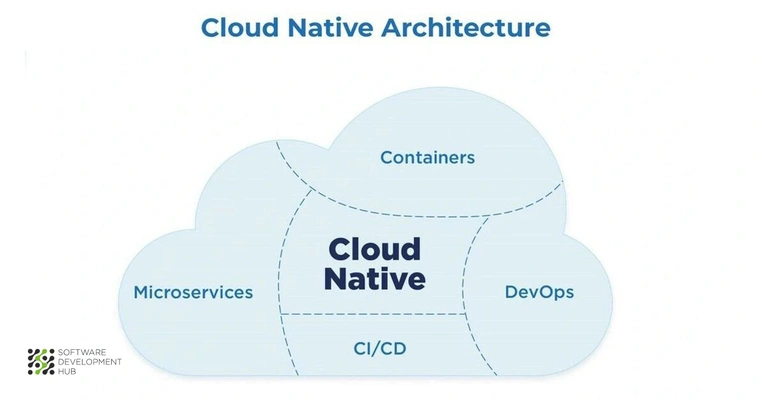What Is Cloud-Native Application Development? Definition & Benefits
The numbers tell a clear story about where software development is heading. Gartner's research shows that by 2025, more than 95% of new digital workloads will be deployed on cloud native platforms. This isn't just another tech trend – it represents a fundamental shift in how organizations approach software development and deployment.
Currently, 82% of enterprises are already using cloud-native development approaches and tools. What drives this adoption? Cloud-native applications differ significantly from traditional software in their architecture and capabilities. These applications are built as loosely coupled, horizontally scalable systems that run on containerized and orchestrated platforms. They typically incorporate one or more constructs that originated specifically in the cloud.
The appeal becomes clear when you consider the practical benefits. Organizations can scale applications dynamically by adding or removing server nodes based on actual demand. This flexibility addresses one of the most persistent challenges in traditional software architecture – the inability to respond quickly to changing resource requirements.
This article examines what cloud-native application development actually means, explores its core principles, and analyzes the concrete benefits it offers for modern software delivery. We'll also address the practical considerations organizations face when implementing these approaches.
What Is Cloud-Native Application Development?
Cloud native application development represents a fundamental shift in how software is built and deployed. Cloud-native applications are specifically designed from the ground up to take advantage of the elasticity and distributed nature of the cloud, rather than simply being hosted there.
Definition of cloud-native application
A cloud-native application is a collection of small, independent, and loosely coupled services designed to deliver business value through well-recognized capabilities. These applications are built using microservices architecture, where each service functions independently, runs in its own process, and communicates via APIs or messaging. Cloud-native technologies enable loosely coupled systems that are resilient, manageable, and observable.
Cloud native refers to an approach that builds and runs software programs within the cloud computing model. This methodology incorporates several core technologies:
- Containerization for packaging code with dependencies
- Microservices for modular development
- DevOps practices for streamlined workflows
- Serverless computing for dynamic resource allocation
Cloud-native applications typically integrate continuous integration (CI) and continuous delivery (CD) practices, allowing developers to integrate changes into a shared code base frequently and without errors.
How it differs from cloud-enabled and cloud-ready models
Understanding the distinctions between these cloud models is essential for organizations evaluating their development strategies.
Cloud-enabled applications are legacy enterprise applications originally running on-premises but modified to run in the cloud. While they can be accessed from browsers, they retain their monolithic structure and lack the flexibility, resilience, and scalability of cloud-native counterparts.
Cloud-ready technologies, though tested in cloud environments at some point during development, were generally not designed for the cloud. They often require significant IT involvement and investment, with lengthy upgrades and integrations.
Cloud-native applications, conversely, are designed to operate only in the cloud, taking full advantage of modern infrastructure's dynamic, distributed nature to achieve greater speed, agility, scalability, reliability, and cost efficiency.
Core Principles of Cloud-Native Architectures

Cloud-native architecture operates on five fundamental principles that work together to create resilient, scalable applications. Understanding these principles is essential for anyone involved in modern software development, as they form the technical foundation that enables the business benefits we discussed earlier.
Microservices for modular development
The microservices approach breaks down monolithic applications into small, autonomous components that handle specific business functions. Each service operates independently, runs in its own process, and communicates through well-defined APIs.
This architectural pattern offers significant advantages over traditional monolithic designs. Development teams can work on different services simultaneously without interfering with each other's work. When changes are needed, developers can modify individual services without risking the stability of the entire application.
Consider a typical e-commerce platform. Rather than building one large application, teams can create separate services for user authentication, product catalog, payment processing, and order management. Each service can be updated, scaled, and deployed independently based on specific business requirements.
Containerization using Docker and Kubernetes
Containerization packages applications with all their dependencies into standardized, portable units. Docker handles the creation and management of these containers, while Kubernetes orchestrates them across distributed systems.
The practical benefits become clear when comparing containers to traditional virtual machines. Containers start significantly faster because they don't need to boot an entire operating system. This speed enables rapid scaling and deployment, which is crucial for applications that need to respond quickly to changing demand.
Moreover, containers ensure consistency across different environments. An application that runs in a developer's laptop will behave identically in staging and production environments, eliminating the common "it works on my machine" problem.
Stateless processing and elasticity
Stateless applications treat each request independently, without storing session information between requests. This design pattern enables true cloud elasticity—the automatic scaling of resources based on actual demand.
The financial implications are significant. Organizations pay only for resources they actually use, avoiding both overprovisioning and underprovisioning. This model works particularly well for applications with fluctuating workloads.
E-commerce platforms during holiday sales exemplify this principle. Traffic can spike dramatically during promotional events, then return to normal levels. Stateless design allows these platforms to scale up during peak periods and scale down afterward, optimizing both performance and costs.
Serverless and consumption-based models
Serverless computing removes infrastructure management entirely from the development equation. Developers focus purely on writing code while cloud providers handle all server provisioning, scaling, and maintenance.
This model pairs well with consumption-based pricing, where organizations pay only for actual resource usage rather than pre-allocated capacity. Serverless architectures can automatically scale to zero when not in use, eliminating idle resource costs while maintaining the ability to respond instantly to demand spikes.
The approach particularly benefits applications with unpredictable or intermittent usage patterns. Development teams can build and deploy functionality without worrying about server management, allowing them to focus on delivering business value rather than managing infrastructure.
Top 8 Benefits of Cloud-Native Application Development
Cloud native architecture delivers quantifiable advantages that reshape how organizations approach software development and deployment. The following eight benefits explain why forward-thinking businesses increasingly adopt this approach.
1. Faster time to market with CI/CD pipelines
Continuous integration and delivery automates the software release process, allowing teams to integrate updates and deploy code changes with greater frequency. CI/CD pipelines enable developers to identify and resolve bugs earlier in the development cycle, which accelerates the overall feedback process. Organizations implementing CI/CD practices report measurable improvements across critical metrics including lead time, deployment frequency, and change failure rate.
2. Improved scalability through container orchestration
Container orchestration automatically provisions, deploys, scales, and manages containerized applications. This automation significantly reduces manual effort when managing large-scale applications. According to IBM, 70% of surveyed developers now use container orchestration solutions. Kubernetes specifically enables clustering of hosts across public, private, or hybrid clouds, making it particularly suitable for applications that require rapid scaling.
3. Cost efficiency via pay-as-you-go infrastructure
Pay-as-you-go models eliminate wasted resources by charging only for actual usage. This approach ensures optimal performance while conserving resources and reducing operational costs. Organizations pay for bandwidth consumed rather than pre-allocated capacity that might remain unused. This pricing structure enables businesses with fluctuating workloads to innovate and scale without large upfront investments.
4. Enhanced DevOps collaboration and automation
DevOps practices simplify development processes and foster collaboration between teams that were previously isolated. This integration promotes rapid adaptation to changing market demands. When organizations combine DevOps with cloud-native architecture, they create reliable frameworks for regular software delivery, enhancing both agility and resilience.
5. Portability across cloud environments
Cloud-native applications can operate across various providers and even on-premises in hybrid models. This portability prevents vendor lock-in not just contractually, but by enabling actual workload mobility. Teams can design applications to be built and deployed across any cloud because they're no longer dependent upon proprietary tools.
6. High availability and fault tolerance
Fault tolerance operates at multiple levels in cloud-native systems, from data redundancy to control plane resilience. Distributed architectures with automatic failover mechanisms ensure continuous data access and minimal service disruption. Multi-cluster deployments distribute workloads to guarantee high availability, with automatic traffic redirection to healthy clusters based on real-time health checks.
7. Reduced vendor lock-in with open standards
Open standards ensure different cloud platforms can communicate seamlessly. They enable interoperability, portability, and vendor neutrality, allowing companies to move applications between providers with minimal friction. This flexibility optimizes cloud spending by giving businesses freedom to choose the most cost-effective provider at any time.
8. Flexibility for legacy modernization and greenfield apps
Cloud-native development offers flexibility for both new projects and legacy modernization. For greenfield applications, it enables teams to design systems specifically optimized for cloud environments. For existing applications, cloud-native approaches help reduce IT complexity, improve process flexibility, and enable collaboration across platforms. Organizations modernizing legacy systems report productivity gains up to 60% through cloud-native transformation.
Challenges and Strategic Solutions in Cloud-Native Adoption
What happens when the promising benefits of cloud-native development meet the reality of implementation? Organizations quickly discover that adoption involves more than simply choosing the right technologies. The path to successful cloud-native transformation requires addressing several interconnected challenges.
Managing cloud complexity and service sprawl
Cloud environments generate an overwhelming volume, variety, and velocity of telemetry data, particularly in microservices and containerized applications. The situation becomes more complex as organizations adopt hybrid and multi-cloud strategies, with 80% of public cloud decision-makers at government organizations using hybrid cloud and 71% employing multiple public clouds. Data silos emerge from multiple agents and disparate monitoring tools, making it difficult to understand interdependencies across applications and digital channels.
This complexity isn't just a technical problem—it directly impacts operational efficiency and decision-making capabilities. Teams often struggle to maintain visibility across distributed systems, leading to longer troubleshooting times and reduced system reliability.
Bridging the cloud-native skills gap
Technical expertise requirements for cloud-native development often exceed available talent in the market. Over 85% of surveyed IT decision-makers report that skills shortages impact their ability to achieve business goals. Organizations face significant recruitment challenges, with 44% struggling to find qualified candidates and 98% experiencing some degree of cloud skills gap. The World Economic Forum estimates that by 2025, 50% of all employees will need reskilling due to organizations adopting new technologies.
The skills gap extends beyond technical capabilities to include operational knowledge, security practices, and architectural decision-making expertise. Organizations must invest in comprehensive training programs or risk suboptimal implementations.
Security risks in distributed systems
Security concerns multiply in distributed architectures. Research shows that 96% of third-party container applications deployed in cloud infrastructure contain known vulnerabilities. The attack surface expands significantly with numerous microservices and components, providing attackers with more potential entry points. Misconfigurations represent another major risk, particularly common in complex cloud environments.
Traditional security approaches often prove inadequate for cloud-native architectures. Organizations need new strategies that account for dynamic, distributed systems where services constantly change and communicate through APIs.
Service discovery and observability issues
How do you monitor what you can't see? Service discovery becomes both essential and challenging in dynamic cloud-native environments. Services constantly change locations based on factors like autoscaling and upgrades. Observability proves difficult due to the inability to monitor and measure across distributed systems effectively. Organizations often struggle with disparate data sources, making it nearly impossible to understand interdependencies.
Without proper observability, teams operate blind, unable to proactively identify issues or optimize performance across their distributed applications.
Platform engineering as a solution
Platform engineering addresses these challenges by creating Internal Developer Platforms (IDPs) that abstract underlying complexities. Gartner predicts this approach will be adopted by 80% of IT companies by 2026. Organizations implementing platform engineering report substantial improvements: 30% faster time to market and 4x higher deployment frequency.
This approach shifts focus from managing individual tools and processes to creating cohesive platforms that enable developer productivity while maintaining operational excellence.
The Future of Cloud-Native Development
Cloud-native application development has moved beyond experimental technology to become a core business strategy. The evidence we've examined throughout this article demonstrates how organizations across industries are reshaping their software development practices to meet modern market demands.
The adoption trajectory speaks for itself. Organizations that have embraced cloud-native methodologies report measurable improvements in deployment frequency, time to market, and operational efficiency. This isn't simply about following technology trends – it's about maintaining competitive advantage in increasingly dynamic markets.
What makes cloud-native architecture particularly valuable is its alignment with modern business requirements. Microservices enable teams to work independently and deploy faster. Containerization ensures consistency across development and production environments. API-first design facilitates integration with third-party services and internal systems. Stateless processing provides the elasticity that modern applications require.
The business benefits extend well beyond technical improvements. Organizations implementing CI/CD pipelines report faster response to market changes. Container orchestration reduces operational overhead. Pay-as-you-go infrastructure models align costs with actual usage. DevOps practices break down traditional silos between development and operations teams.
Cloud-native development fundamentally changes how software supports business objectives. Rather than viewing applications as static systems, organizations can now build software that adapts dynamically to changing requirements. This capability has become essential for companies that need to respond quickly to market opportunities and customer demands.
The shift toward cloud-native approaches represents more than technological evolution – it reflects a broader change in how businesses compete through software capabilities. Organizations that master these approaches position themselves to innovate faster and respond more effectively to market changes than those relying on traditional development methods.
Categories
About the author
Share
Need a project estimate?
Drop us a line, and we provide you with a qualified consultation.







